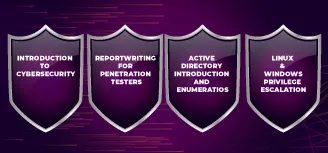Key Features:
,1. Global Certifications: Elevate your professional profile with six globally recognized certifications, including CCNA, CEH v12 (Theory and Practical), AWS Cloud Security, Palo Alto PCNSA, and SOC Analyst from EC-Council. These certifications are integrated into our cyber security masters program, offered by the best masters in cyber security training institute in Mumbai.
2. Holistic Curriculum: Our program delivers a comprehensive education across various cybersecurity domains. Designed to meet industry needs, the curriculum covers threat detection, network security, cloud security, and more. This robust training is provided by the best masters in cyber security training institute in Thane and Andheri, ensuring you receive top-notch instruction in MCS in cyber security.
3. Duration: Spanning 12 months, the program allows participants to progressively build and apply their knowledge. This extended duration ensures a thorough understanding of complex topics and fosters practical skills development. As one of the best online masters in cybersecurity course in Thane and Andheri, it offers flexible learning tailored to your schedule.
4. Practical Emphasis: Gain hands-on experience through practical scenarios and simulations that bridge the gap between theory and real-world application. This practical approach is a hallmark of the best cyber security training institute near me, preparing you effectively for real-world cybersecurity challenges.
5. Career Trajectory:Graduates of this cyber security masters program can expect a competitive CTC (Cost to Company) starting at 5 LPA. The program aligns with industry demands, positioning graduates favorably in the job market.
6. Industry-Relevant Levels: Advance through 11 expertly designed levels that build your expertise from foundational principles to advanced cybersecurity strategies. This structure ensures continuous growth and aligns with the high standards of the best masters in cyber security training institute in Thane and Andheri.
Module
- Introduction to Ethical Hacking
- Foot Printing & Reconnaissancer
- Scanning Network
- Enumeration
- Vulnerability Analysis
- System Hacking
- Malware Threats
- Sniffing
- Social Engineering
- Denial of Service
- Session Hijacking
- Evading IDS, Firewall & Honeypots
- Hacking Web Servers
- Hacking Web Applications
- SQL Injections
- Hacking Wireless Networks
- Hacking Mobile Platforms
- IOT Hacking
- Cloud Computing
- Cryptography
- Introduction to Penetration Testing
- Web Application Introduction & API
- Clickjacking Attack
- PHP Programming Basics
- Cross Site Scripting Attacks: Manual
- Advance SQL Injections
- Cross Site Request Forgery
- Host Header Injection
- Privilege Escalation Injection
- Directory Traversal
- Insecure Deserialization
- Remote Code Execution
- Hacking Web Server with Metasploit
- Brute Forcing Web App/No Rate Limit
- Server Side Request Forgery
- Subdomain Taker Over
- Reporting Bugs
- Introduction to Vulnerability Management
- Understanding Vulnerabilities (types, classification, and severity)
- Risk Management Fundamentals
- MBSS & CR Compliance
- Vulnerability Scanning and Assessment
- Network and System Discovery
- Asset Inventory and Classification
- Vulnerability Intelligence Sources (NVD, CVE, CVSS)
- Risk-Based Vulnerability Prioritization
- Vulnerability Classification and Scoring (CVSS)
- Remediation Strategies (patching, configuration, mitigation)
- Patch Management Best Practices
- Vulnerability Management Lifecycle
- Identifying and Analyzing Vulnerabilitie
- Prioritizing and Remediating Vulnerabilities
- Introduction to Android Penetration’s Testing
- Preparing Kali Linux and Genymotion
- Using ADB & Installing Apps
- Decompiling Android Applcation
- Dex File Analysis
- Capturing Android Traffic
- Insecure Logging
- Hardcoding Issues
- Insecure Data Storage (Part 1 - 4)
- Input Validation Issue (Part 1- 3)
- Access Control Issue (Part 1 - 3)
- Android PT with Frida
- Hardcoding Issues (Part - 2)
- Input Validation Issue (Part - 3)
- Introduction to What is an API
- Interacting with API's
- Types of API's
- API Security
- Lab Setup
- Tool Installation
- Burp Suit Introduction
- Postman Introduction
- Risk-Based Vulnerability Prioritization
- Docker introduction
- Enumerating API's
- Introduction to Enumeration
- Fuzzing API's
- Discovery via Source Code
- Attacking Authorization
- Introduction to Authorization
- BOLA Lab
- BFLA Labs
- Challange solution
- Attacking Authentication
- Introduction to Authentication
- Network Fundamentals
- Network Scanning and Enumeration
- Vulnerability Scanning and Analysis
- Network Penetration Testing
- Wireless Network Security
- Network Defense and Countermeasures
- Network Security Testing Tools (Nmap, Nessus, etc.)
- Network Vulnerability Exploitation
- Network Penetration Testing Methodologies
- Reporting and Documentation
- Network Segmentation and Isolation
- Secure Communication Protocols
- Network Encryption
- Firewalls and Access Control
- Incident Response and Recovery
- Computer Forensics in Today's World
- Computer Forensics Investingation Process
- Understanding Hard Disks & File System
- Data Acquisition & Duplication
- Defeating Anti-Forensics Techniques
- Windows Forensics
- Linux & MAC Forensics
- Network Forensics
- Investingating Web Attacks
- Dark Web Forensics
- Cloud Forensics
- Investingating Email Crimes
- Malware Forensics
- Mobile Forensics
- IOT Forensics
- About Cyber Security Industry
- Setting up Hacking Machine
- Introduction to Networking
- Web Application Fundamentals & Configurations
- Introduction to Web Application Security Testing
- Web Application Reconnaissance
- Working with Burp suite
- Exploiting Traditional Web Application Vulnerabilities
- Introduction to Session Managements
- Introduction to XSS (Cross-Site Scripting)
- Introduction to SQL injection
- Introduction to File Inclusion Vulnerability
- CSRF (Cross-Site Request Forgery Attack)
- SSRF (Server-Side Request Forgery Attack)
- IDOR (Insecure Direct Object Reference)
- OS Command injection
- Response Manipulation
- Host Header Injection
- Parameter Tampering
- XXE (XML External Entity)
- RCE (Remote Code Execution)
- Introduction to Bug Bounty Platforms
- Security Operations and Management
- Understanding Cyber Threats, ioCs, and Attack
- Incidents, Events, and Logging
- Incident Detection with Security Information
- Enhanced Incident Detection
- Incident Response
- Security Fundamentals
- Cloud Security Principles and Framework
- Indentify and Access Management
- Detective Controls
- Infrastructure Protection




